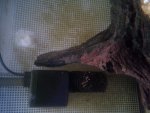Cyanobacteria is normally caused by LOW nitrates in planted tanks. Lack of flow to the affected area is also very likely to be the cause.
Is your tank planted? Are you dosing any fertilizers for the plants? In planted tanks with fertilizers, what usually happens is, the plants can't take up other nutrients in the water column and grow due to the limiting nutrient of nitrogen through low nitrates. The abundance of other nutrients in the water column are what allow algae to grow, and specifically in this case, cyanobacteria because it can live in low nitrate environments better than other algaes.
Determine the cause and correct it or the algae will come back.
If the lighting is too high, raise the light, reduce the time it's on or get a lower intensity light.
Check your water parameters, especially nitrates in this case. If they are low but you don't have live plants or dose fertilizer, it's more than likely the light and lack of flow.
Once you take care or the cause then treat with erythromycin. For the course of the treatment, your biological filter should survive. Monitor parameters after the treatment to pick up on any damages (mini cycle) and do water changes until the bacteria catches back up. (I've done the erythromycin treatment on cyanobacteria and my biological filter survived 100%.)
If the erythromycin doesn't kill it, it isn't cyanobacteria.
Remember, with antibiotics, you need to complete the full course of treatment so you don't create resistant bacteria.

